Using plants to keep indoor insects outdoors
Seven plants that work wonders
Here are 7 plants that can keep insects at bay. These seven plants have proven to get the job done.
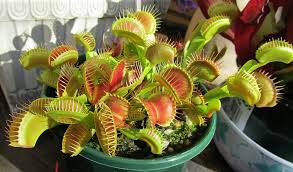
The world of insects is so fascinating. In fact, it is estimated that there are more than 9 quintillion species of insect worldwide. Many of these insects invade our gardens, landscapes and homes. These insects are divided into two groups, the bad bugs that feed on and destroy our garden plants and the good bugs that police our gardens by feeding on the bad bugs. The good bugs are also known as beneficial insects. Bees are beneficial insects, they may not feed on the bad bugs but they contribute to our gardens by pollinating garden plants.
The world of plants is amazing because many of these garden pests can be brought under control by some of these plants that repel and consume garden pests.
That is all well and good but what about insects that invade our homes, how can we control them with plants. The advantage of using plants is that this is a natural way to control indoor insects vs using sprays which can be harmful to humans and pets.
While it is true that at some point insect sprays may be needed, it is good to limit their use so we can breathe pure air which helps in promoting good health.
Have you ever had a battle with indoor pests that sought to pay you a visit as you were in the kitchen preparing that delicious meal, or sitting at the dinner table?
While there are are many sprays on the market that promise to keep human and pets safe while eliminating insect pest, it is good to have a few indoor plants that can help with this issue.
Indoor pest-repellent plants
Insects like other wildlife invade our homes for three reasons which are water, food and shelter therefore many homeowners face the challenge of keeping these insects at bay.
But what if there is a way to eliminate them from your home, the good news is there is a way to accomplish this and that’s by using plants to help with this process. Here are several plants that can go to work for you.
Plants that repel indoor insects
A. Topping the list is the venus fly trap. This plant is famous for making a meal out of the common household flies that can really be a menace. Flies are known to spread disease. Here is a cool video of the venus fly trap in action.
How to care for venus flytrap
1. The soil of the venus flytrap should be a soilless mix such as peat moss and horticultural sand.
2. The venus flytrap should be watered with rain or distilled water. Keep soil moist not waterlog because too much water will cause root rot.
3. Plants can be grown in plastic containers
4. Containers should have drain holes for drainage.
5. Venus flytrap needs twelve hours of sunlight.
6. Feeding them with small insects will keep them healthy.
7. As your plant grows, transplant it into a bigger pot.
8. Don’t let you venus flytrap flower.
9. Prune plant parts that are dead.
B. Lavenders are an amazing herb that has many benefits, this plant is used for its flavour, scent and beautiful flowers. But do you know that lavenders can be used to repel indoor insects?
Once your lavender plant flowers, use a few as flower cuttings. Place these cuttings in a vase, as the lavenders dry it will produce a sweet fragrance that will repel or keep insects at bay.
Indoor pest-repellent plants
How to care for lavenders
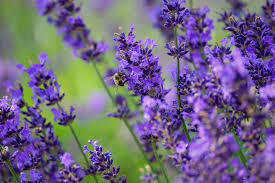
1. Using a good potting mix will ensure that your lavender plants are growing healthy.
2. Containers should have drain holes to allow for excess water to drain.
3. Do not over water because overwatering will cause root rot. Soil should be somewhat moist and not waterlogged.
4. Using a slow release fertilizer will help your plant to remain healthy.
5. For more on how to grow and care for lavenders follow the link.
C. Basil is one of my favourites. This herb can really flavour your foods such as bake, steam foods, rice and so on. I have used this herb over the years and still get a trill of cooking with them.
Besides its great taste basil has a wonderful aroma. But this wonderful aroma is offensive to houseflies and mosquitoes. Basils can be grown and cared for as an indoor plant. For more on growing and caring for basils as an indoor plant follow the link. Growing indoor edible plants.
How to care for basils
1. To grow healthy basil indoors and out choose an area that gets a lot of sunlight.
2. Soil type should be good garden soil, organic mix or compost. Starting a compost pile and composting indoors.
3. Containers can be from three gallons and larger depending on the size of plant and area where it is to be installed. Basil that’s small can be placed on the kitchen counter or other areas that have a counter or top but ensure these areas are getting sufficient sunlight which is so important for basils to survive.
4. The soil of basil should be kept somewhat moist and not waterlogged because too much water will cause root rot.
5. Ensure that pots have drain holes to allow excess water to drain.
6. Place a saucer under plant pot to collect the water.
7. The water that is collected in the saucer should be discarded because if water is not emptied from the saucer will become stagnant and will become a breathing ground for mosquitoes.
8. Using an organic fertilizer or quick release will help your basils to remain in tip-top shape.
D. I love cooking with rosemary, every chance I get the sweet aroma of this herb emanates from my kitchen. Rosemary has such a unique flavour, be very careful when cooking with this herb. Though it flavours your foods, too much of this herb can be overpowering giving your foods a bitter taste.
Just a few leaves from this herb can really make those dishes mouthwatering. I use rosemary in steam, baked, broil foods and even rice just to name a few. But do you know that this herb which has such a pleasant aroma along with a delightful taste will have insects packing or running for their lives?
The scent of rosemary repels bugs, flies and mosquitoes. Placing a few potted rosemary near your door on the outside provided that area gets sufficient sunlight will help in keeping these insect pests at bay.
Placing a container grown rosemary on your kitchen counter is also good when fighting of insect pest.
Indoor pest-repellent plants
How to care for rosemary
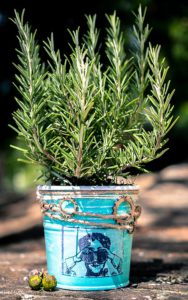
1. Choose a sunny location that gets about five to six hours of sunlight.
2. The use of a quality garden soil, compost or organic soil mix is a must.
3. The size of the container that is chosen depends on the size of the rosemary herb you choose to grow.
4. Containers should have drain holes for excess water.
5. Saucers should be kept under the container to collect water. Empty saucer because stagnant water can encourage mosquitoes to lay eggs.
6. Using an organic or quick release fertilizer will help your rosemary to remain in tip-top shape.
As plants grow harvest a few leaves. What I love about herbs is while they kept insects at bay can also be used to flavour your foods. Oh, the beauty and wonders of herbs.
E. What about mint? The mint plant is truly amazing, I discovered this herb many years ago and was so surprised because of the aroma this herb was giving off which had the aroma of a mint candy.
The leaves of peppermint herb can be used to make a fresh brew of tea that is good for upset stomach or getting rid of gas. The recipe calls for 2 tbsp spoons of freshly harvested leaves in a cup of boil water.
Let leaves seep in water for 10-12 minutes strain and add honey or brown sugar, sweeten to taste and enjoy.
But as pleasant as peppermint is the scent of this herb is hated by mosquitoes and other insects. Peppermint can be grown in containers and place in areas that get lot’s of sunlight, near the door entrance and even on the kitchen counter along with other places in the home providing there’s sufficient sunlight.
This herb will not only keep insects at bay but will provide a minty fresh environment.
If planting peppermint directly into the ground beware because this herb is evasive and will take over your garden. Peppermint needs a lot of room to grow when installing in a garden area so give them their space and control their growth by keeping them well pruned.
How to care for peppermint
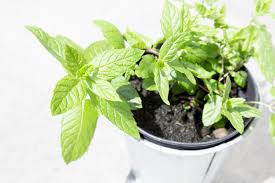
1. Choose a sunny location that gets about five to six hours of sunlight.
2. The use of a quality garden soil, compost or organic is a must.
3. The size of the container that is chosen depends on the size of the plant to be grown.
4. Containers should have drain holes for excess water.
5. A saucer should be kept under the container to collect water. Empty saucer because stagnant water can encourage mosquitoes to lay eggs.
6. Using an organic or quick release fertilizer will help your peppermint plant to remain healthy.
As plants grow harvest a few leaves to enjoy as a tea or to flavour meats.
For more on the benefits of herbs and how to grow, an care for them follow the links. The healing wonders of herbs and how to grow herbs. Also to add a little spice to your life check out this the link. Homemade herb seasoning.
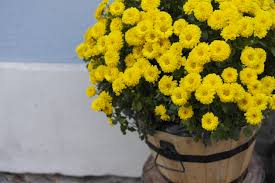
F. Chrysanthemums are beautiful plants that can be grown outdoors and makes a great centrepiece indoors with their flowers that is so inviting warming the heart. But as beautiful as chrysanthemums are they have been known to keep insects such as silverfish, roaches, bedbugs, ants, lice and ticks at bay.
Grow these beauties in your home garden and when the season comes for them to be in full bloom remove several of them from your garden using as cut flowers and placing them in a vase with fresh water, placing them in different parts of your home will not only look amazing but will have these listed insects running. Chrysanthemums can also be grown in pots and place indoors
How to care for chrysanthemums
1. Purchase chrysanthemums that are climatized for the indoors. If you’re not repotting them then skip these steps but place plant in an area of your home that gets 5-6 hours of sunlight.
2. If transferring chrysanthemums to a larger pot, choose a good garden soil.
3. Containers that are chosen should have draining holes to allow for excess water to drain
4. keep soil somewhat moist. Do not overwater.
5. Fertilize with a liquid feed fertilizer.
To preserve your chrysanthemum as cut flowers the water in the vase should be changed every 2-3 days. Cuttings should also be placed in areas that get sufficient sunlight.
G. Lemon balm has been used as a mosquito repellent. The lemon balm herb can add that wow to your foods besides it sweets fragrance but when it comes to mosquito they hate the smell, the question is what’s there to hate about this herb?
The sweet aroma of lemon balm will cause mosquitoes to check out with no intention of returning.
How to care for lemon balm
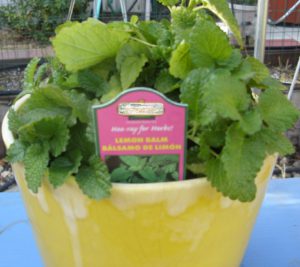
1. When placing lemon balm indoors as a bug repellent, place containers in areas that get at least five hours of sunlight.
2. The soil of the lemon balm should be a well-drained soil. Soils such as a good garden soil, compost or organic soil mix will give best results.
3. Don’t overwater your plant, soil should be moist but not waterlogged.
4. As mention earlier the container should have drain holes to allow excess water to drain on through.
5. Fertilize your lemon balm with a water soluble or liquid fertilizer.
6. For stronger flavours pinch or remove flowers when they appear.
Indoor pest-repellent plants
Note: A word of caution here. When using fertilizers read and follow the label because the label is law.
The final word
The world of plants is pretty fascinating and serve us in so many ways. Using plants is a natural way to keep insects at bay along with providing amazing aromas and flavours to excite our taste buds.
So go ahead and give these herbs a try, trust me you won’t be sorry as you receive the many benefits of container grown plants.
About the author
Norman loves being in the garden, both at home and for his job....
he is 'Natures Little helper' being outdoors, growing his vegetables and flowers from an early age.
Now having spent over 22 years in the profession he want to give some of his knowledge to others...
his vast array of hints and tips you will find scattered over this site will help you no end growing plants in your garden.

Hi Norman,
Great article, I loved the reading!
I have an outdoor plant to repels mosquitos, but it doesn’t really help me because all the mosquitoes are inside the house. So now I am looking for indoor plants to get rid of these mosquitos that prevent me from sleeping at night. I didn’t know that Lavender can be inside the house and that it can repel insects. That’s wonderful because it is one of my favorite plants:).
I hope it will work against mosquitos. What do you think?
Thank you for this excellent post!
Hello Daniella so happy to hear from you. Hope all is well. So sorry to hear about your mosquitoes problem. The good thing however is plants are a great alternative to using insects sprays, the elimination process may be slow but you will get good results without having to breathe harmful chemicals.There is nothing wrong with giving it a try. Hope this helps, all the best of success and have a good
Hi Norman
This was a very interesting article, that I enjoyed every bit. It’s amazing how a simple plant can eliminate the pet problem. I do have a question, I have a problem with gnats and fruit flies everywhere in the house they are driving me crazy, What plant do you recommend that can help me get rid of these nats. Overall love the article, I will be keeping this article in my bookmarked for future pest problems. Thanks for the reply.
Hello so happy to meet you and thanks so much for responding. Plants are pretty amazing and benefits us in so many ways. Unfortunately I have not come across a plant that can control fruit flies and gnats indoors but will look into this. The good news is these pest can be controlled by these natural methods.
1. Place rotten fruits into a jar to attract the gnats and fruit flies.
2. Create a trap by mixing apple cider vinegar with a few drops of dish soap.
3. Mash up banana slices in a jar and cover the top with a plastic wrap.
Hope this help. All the best of success and have a good day.